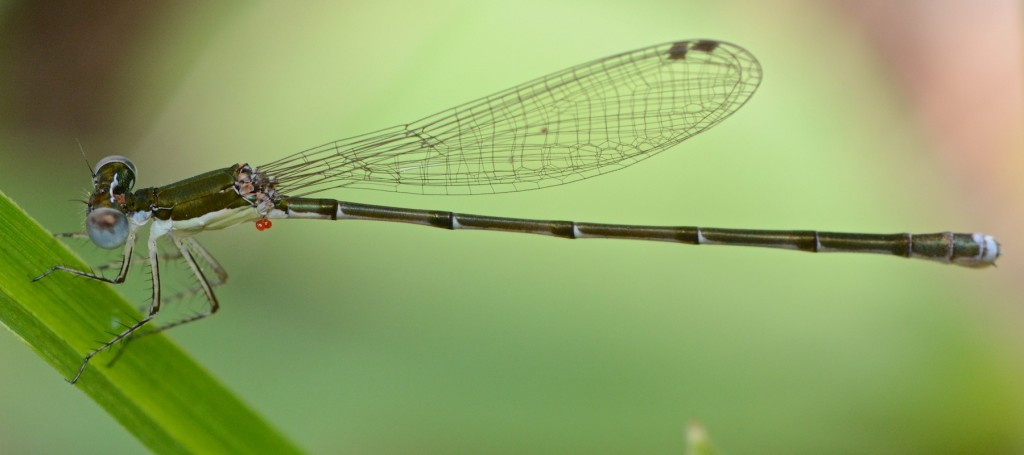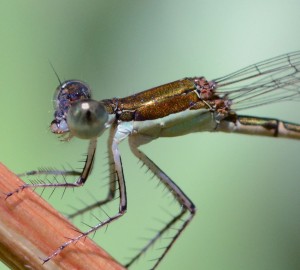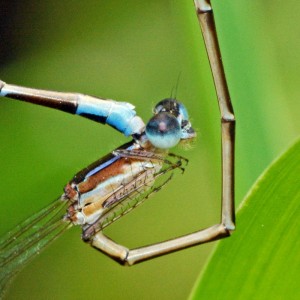Over the weekend I spent a lot of time in the “field,” a fancy name for my small suburban backyard (I say suburban because here in Boca Raton, even with city hall only three blocks away, there is no “urban” to speak of). This was the first weekend after A Lot Of Rain, so there were lots and lots of damselflies to sort through. Dozens of Everglades Sprites (Nehalennia pallidula), several Rambur’s Forktails (Ischnura ramburii), a few Fragile Forktails (Ischnura posita), one or two Citrine Forktails (Ischnura hastata), and, for the first time that I’m aware of, Southern Sprite (Nehalennia integricollis). (A bit later this week I saw a sixth species, Carolina Spreadwing [Lestes vidua]. Yay! But I discovered that they’re MUCH more wary than all other damselfly species combined. Boo!)
As a rule, damselflies are quite a bit less conspicuous than their larger cousins, the dragonflies. Their bodies are slimmer, they tend to hold their smaller wings parallel to their bodies over their backs, rather than perpendicular to their bodies like those great big oars of wings on the dragonflies. They like to flit around in the tall grasses or, if you’re one of those more meticulous lawnkeepers, any shrubby vegetation you might have (although, if you’re a meticulous lawnkeeper, you or your gardener probably use pesticides, so you’re much less likely to see any of these beautiful little mosquito-eaters than those of us who practice a more holistic gardening approach, sometimes referred to as “leaving things alone.”).
The sprite family of damselfly takes this inconspicuousness to the extreme. Hal White, the longtime odonate observer up in the Delmarva peninsula, writes about these little guys as follows:
Because it is inconspicuous and rarely flies unless disturbed, it is easy to overlook even when searching for it. The presence of one Cyrano Darner at a pond attracts attention while hundreds, or even thousands, of Southern Sprites might be at the same location and go unnoticed.
I doubt that there are hundreds, or even dozens, of Southern Sprites in my little quarter acre, but I can certainly say that there’s at least one. And it’s very nice to meet her at long last:

They have the prettiest blue eyes, and a wonderful metallic green color that looks a bit dull in the shade but really lights up when the sun hits it:

Etymology
Nehalennia, as I’ve discussed before, is a river goddess from the Rhine region; the specific name integricollis means that the hind lobe of her prothorax (her collar, if you prefer), where the male damselfly would grasp her for copulation, is “entire,” or complete (integral), rather than interrupted or grooved. Presumably the shape of this region of the thorax matches the terminal abdominal appendages of the male to facilitate reproduction, as illustrated by this pair of Everglades Sprites:

According to Westfall and May, the Southern Sprite is the “smallest, most southern, and least studied of the darker, northern group [there are five species in the genus Nehalennia, and three of them comprise the “northern” group of metallic green damselflies, while the remaining two are part of the “southern” group of darker, browner damselflies]. It is found in areas as diverse as the margins of sandhill lakes in Florida and sphagnum bogs…in New Jersey, but its ecological requirements have evidently never been described in detail.”
Giff Beaton observes that this species “tends to stay in heaviest vegetation, and small size makes observation difficult unless focusing on a small area and looking for movement.” I can certainly attest to that. I’ve been playing hide-and-seek with one or two of these little ladies for days now. Just when I think I’m about to get a good photo, she takes off, and when I finally relocate “her,” I find one of the dozens of Everglades Sprites that are littering my lawn, and she’s nowhere to be found.
So, while we don’t know too much about this lovely little lady, we do know that she’s alive and well in downtown Boca, and perhaps at a natural area near you!
References
Beaton, G. (2007). Dragonflies and Damselflies of Georgia and the Southeast. Athens: U of Georgia P.
Westfall, M. J., and M. May. (2006). Damseflies of North America, Revised Edition. Gainesville: Scientific.
White, H. (2011). Natural History of Delmarva Dragonflies and Damselflies: Essays of a lifelong observer. U of Delaware P.
